Schneider Trophy aircraft
Schneider Trophy aircraft are the racing seaplanes that contested for the Schneider Trophy between 1913 and 1931. By winning its third consecutive contest in 1931, the United Kingdom won the trophy in perpetuity.
| Year | Country | Manufacturer | Model | Designer | Image | Engine | Power | Racing History[lower-alpha 1] | Speed | Notes & Refs |
|---|---|---|---|---|---|---|---|---|---|---|
| 1913 | Deperdussin | Coupe Schneider | Louis Béchereau |  |
Gnome Lambda-Lambda | 160 hp 120 kW |
73.6 km/h 45.7 mph |
|||
| 1913 | Morane-Saulnier | G | Léon Morane Raymond Saulnier |
.jpg.webp) |
Gnome Lambda | 80 hp 60 kW |
92 km/h 57 mph |
|||
| 1913 | Nieuport | VI.G | Gnome Omega-Omega | 100 hp 75 kW |
R (1913)[lower-alpha 2] | — | ||||
| 1914 | Sopwith | Tabloid |  |
Gnome Monosoupape | 100 hp 75 kW |
139.66 km/h 86.78 mph |
[4]:248–249 | |||
| 1914 | FBA | Type B |  |
Gnome Monosoupape | 100 hp 75 kW |
82.35 km/h 51.17 mph |
[4]:248–249 | |||
| 1919 | Savoia | S.13 | _scheda_Aerei_da_Guerra.jpg.webp) |
Isotta Fraschini V.6 | 250 hp 190 kW |
DQ (1919) | — | |||
| 1919 | Fairey | III | Napier Lion | 450 hp 340 kW |
R (1919) | — | [4]:306 | |||
| 1919 | Sopwith | Schneider | Cosmos Jupiter | 450 hp 340 kW |
R (1919) | — | [4]:245–247 | |||
| 1919 | Supermarine | Sea Lion I | .jpg.webp) |
Napier Lion | 450 hp 340 kW |
R (1919) | — | [4]:306 | ||
| 1920 | Savoia | S.12 | Ansaldo 4E29 | 550 hp 410 kW |
172.56 km/h 107.22 mph |
[4]:268 | ||||
| 1921 | Macchi | M.7bis | Isotta Fraschini V.6 | 250 hp 190 kW |
189.68 km/h 117.86 mph |
[4]:295–296 | ||||
| R (1921)[lower-alpha 3] | — | |||||||||
| 1921 | Macchi | M.19 |  |
Fiat A.14 | 650 hp 480 kW |
R (1921) | — | [lower-alpha 4][4]:290 | ||
| 1922 | Supermarine | Sea Lion II | .jpg.webp) |
Napier Lion | 450 hp 340 kW |
234.52 km/h 145.72 mph |
[lower-alpha 5][4]:306 | |||
| 1922 | Savoia | S.51 | Hispano-Suiza 8F | 300 hp 220 kW |
230.93 km/h 143.49 mph |
[4]:294 | ||||
| 1922 | Macchi | M.17 |  |
Isotta Fraschini V.6 | 260 hp 190 kW |
213.63 km/h 132.74 mph |
[4]:295–296 | |||
| 4 (1922)[lower-alpha 6] | 199.61 km/h 124.03 mph | |||||||||
| 1923 | Curtiss | CR-3 | _Cowes%252C_England_Sep1923.jpg.webp) |
Curtiss D-12 | 475 hp 354 kW |
285.46 km/h 177.38 mph |
||||
| 278.97 km/h 173.34 mph | ||||||||||
| 1923 | Supermarine | Sea Lion III | .jpg.webp) |
Napier Lion III | 525 hp 391 kW |
252.93 km/h 157.16 mph |
[lower-alpha 8] | |||
| 1923 | CAMS | 38 | Hispano-Suiza 12Fd Spécial | 380 hp 280 kW |
R (1923) | — | ||||
| 1925 | Curtiss | R3C.2 |  |
Curtiss V-1400 | 565 hp 421 kW |
374.27 km/h 232.56 mph |
[lower-alpha 9] | |||
| R (1925)[lower-alpha 10] | — | |||||||||
| 1926 | 372.34 km/h 231.36 mph | |||||||||
| 1925 | Gloster | III |  |
Napier Lion VII | 700 hp 520 kW |
320.58 km/h 199.20 mph |
[lower-alpha 12] | |||
| 1925 | Macchi | M.33 | Curtiss D-12 | 500 hp 370 kW |
271.08 km/h 168.44 mph |
|||||
| 1925 | Supermarine | S.4 | R. J. Mitchell |  |
Napier Lion VII | 680 hp 510 kW |
C (1925) | —[lower-alpha 13] | [lower-alpha 14] | |
| 1926 | Macchi | M.39 | Mario Castoldi |  |
Fiat AS.2 | 800 hp 600 kW |
396.70 km/h 246.50 mph |
|||
| 350.85 km/h 218.01 mph | ||||||||||
| R (1926)[lower-alpha 17] | — | |||||||||
| 1926 | Curtiss | F6C-1 | 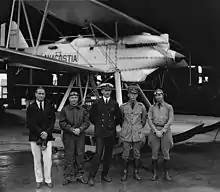 |
Curtiss D-12A | 507 hp 378 kW |
4 (1926) | 220.41 km/h 136.96 mph |
|||
| 1926 | Curtiss | R3C.4 |  |
Curtiss V-1550 | 685 hp 511 kW |
R (1926) | —[lower-alpha 18] | |||
| 1927 | Supermarine | S.5 | R. J. Mitchell |  |
Napier Lion VIIB | 875 hp 652 kW |
453.28 km/h 281.66 mph |
|||
| Napier Lion VIIA | 900 hp 670 kW |
439.45 km/h 273.06 mph | ||||||||
| 1929 | Napier Lion VIIB | 875 hp 652 kW |
454.02 km/h 282.11 mph | |||||||
| 1927 | Gloster | IVB |  |
Napier Lion VIIB | 875 hp 652 kW |
R (1927) | —[lower-alpha 19] | |||
| 1927 | Macchi | M.52 | Mario Castoldi | 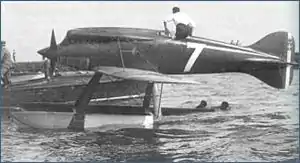 |
Fiat AS.2 | 800 hp 600 kW |
R (1927)[lower-alpha 20] | — | [lower-alpha 21] | |
| Fiat AS.3 | 1,000 hp 750 kW |
R (1927)[lower-alpha 20] | — | |||||||
| 1929 | 457.38 km/h 284.20 mph | |||||||||
| 1927 | Short | Crusader | W.A. Bristow |  |
Bristol Mercury | 870 hp 650 kW |
C (1927) | — | [lower-alpha 23] | |
| 1927 | Kirkham-Williams | Racer | Alford Williams | 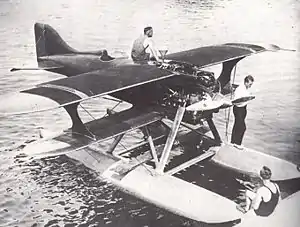 |
Packard X-2775 | 1,250 hp 930 kW |
W (1927) | — | ||
| 1929 | Supermarine | S.6 | R. J. Mitchell | Rolls-Royce R | 1,900 hp 1,400 kW |
528.88 km/h 328.63 mph |
||||
| DQ (1929)[lower-alpha 24] | — | |||||||||
| 1929 | Macchi | M.67 | Mario Castoldi | 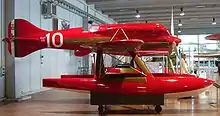 |
Isotta Fraschini Asso 2-800[lower-alpha 25] | 1,800 hp 1,300 kW |
R (1929)[lower-alpha 26] | —[lower-alpha 27] | ||
| 1929 | Gloster | VI |  |
Napier Lion VIID | 1,320 hp 980 kW |
F (1929) | [lower-alpha 28] | |||
| 1929 | Savoia-Marchetti | S.65 | 2× Isotta Fraschini Asso 1-500[6] | 1,000 hp 750 kW (×2) |
W (1929) | [lower-alpha 29] | ||||
| 1929 | Fiat Aviazione | C.29 | Celestino Rosatelli | 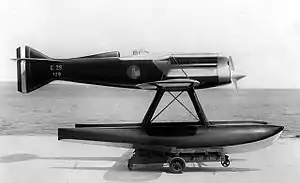 |
Fiat AS.5 | 1,050 hp 780 kW |
W (1929)[lower-alpha 30] | |||
| 1929 | Piaggio | P.7 | 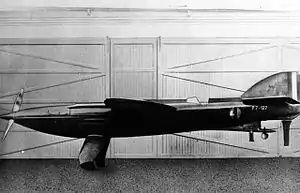 |
Isotta Fraschini Asso 1-500 | 980 hp 730 kW |
W (1929) | —[lower-alpha 31] | [lower-alpha 32] | ||
| 1931 | Supermarine | S.6B | R. J. Mitchell |  |
Rolls-Royce R | 2,350 hp 1,750 kW |
547.30 km/h 340.08 mph |
[lower-alpha 33] | ||
| 1931 | Macchi | M.C.72 | Mario Castoldi |  |
Fiat AS.6 | 2,500 hp 1,900 kW |
W (1931) | —[lower-alpha 34] | [lower-alpha 35] |
- Table notes
- Place of finish and year, or
C: crashed prior to race
DQ: disqualified after finish
F: failed to qualify for race
R: entered race, but retired before finish
W: withdrawn from race - Two entrants in the 1913 race; both retired prior to finish.
- Second entry in 1921 race; flown by Corgnolino, retired on 16th lap.
- Largest wing area of any Schneider Trophy entry.
- Last flying boat to win.
- Second entrant in 1922 race.
- Took 1st and 2nd place in 1923.
- 1922 Sea Lion II using new, uprated engine.
- The last biplane to win the Schneider Trophy.
- Three entrants total in 1925 race; two retired.
- 2nd place at 1926 race.
- The shortest wingspan of all Schneider racers at 20'
- Maximum speed 381 km/h (237 mph).
- Crashed during qualification, most likely from wing flutter of un-braced cantilever wing.
-
- 5, flown by De Bernardi.
-
- 1, flown by Bacula.
-
- 3, flown by Ferrarin, retired 4th lap.
- Maximum speed 390 km/h (240 mph).
- Calculated maximum speed 445 km/h (277 mph).
- Two entrants in 1927, one powered by Fiat AS.2, the other by AS.3; both retired.
- Featured swept back wings.
- 2nd place 1929 as M.52R.
- Crashed during race trials.
- N.248 piloted by Atcherley was disqualified for missing a pylon.
- The Asso 2-800 (also known as the Asso 750 M) was developed from the Asso 750 by increasing the bore and stroke by 10 mm (0.39 in), increasing the compression ratio, and also fitting unique cylinder heads, carburetors, and crankcase. Typical output was closer to 1,400 horsepower (1,000 kW).[5]
- Both entries failed to finish 1929 race.
- Calculated maximum speed was 565 km/h (351 mph).
- Fuel supply problems.
- Utilized tractor and pusher propellers to eliminate prop torque that could sink float on one side.
- Aircraft was not ready in time for racing.
- Top speed was estimated at 580 km/h (360 mph).
- This radical design with hydro-vanes instead of floats with its fuselage floating in the water. The propeller pivoted upwards on take off and landing; however, prop/clutch problems between the water and air propellers proved insoluble.
- With the third straight win for Great Britain, won the Trophy permanently.
- Maximum speed of 709 km/h (441 mph) was demonstrated after the race.
- The final Schneider design was completed after final races and was the fastest by a very large margin. It was the only model with Contra-rotating propellers.
See also
References
- Barker, Ralph (1981). The Schneider Trophy Races. Shrewsbury, UK: Airlife Publishing Ltd. ISBN 0-906393-15-9.
- Weyl, Alfred Richard (August 1932). Translated by J. Vanier, National Advisory Committee for Aeronautics. "Der Wettbewerb um den Schneider-Pokal" [The Schneider Trophy Contest] (PDF). Zeitschrift für Flugtechnik und Motorluftschiffahrt. R. Oldenbourg. 23 (15).
- Pecastaingts, Pierre (1996). "Schneider Trophy". HydroRetro. Translated by Gib Dickerhoof. Retrieved 22 May 2020.
- "Section XVIII: Description of Various Vertical, Vee, and "W" Type Engines". Technical Regulations No. 1440-55: Air Corps – Aircraft Engines (Report). War Department. June 30, 1927.
- Pearce, William (April 5, 2019). "Isotta Fraschini W-18 Aircraft and Marine Engines". Old Machine Press. Retrieved 28 May 2020.
- Pearce, William (September 20, 2016). "Savoia-Marchetti S.65 Schneider Racer". Old Machine Press. Retrieved 28 May 2020.
External links
This article is issued from Wikipedia. The text is licensed under Creative Commons - Attribution - Sharealike. Additional terms may apply for the media files.